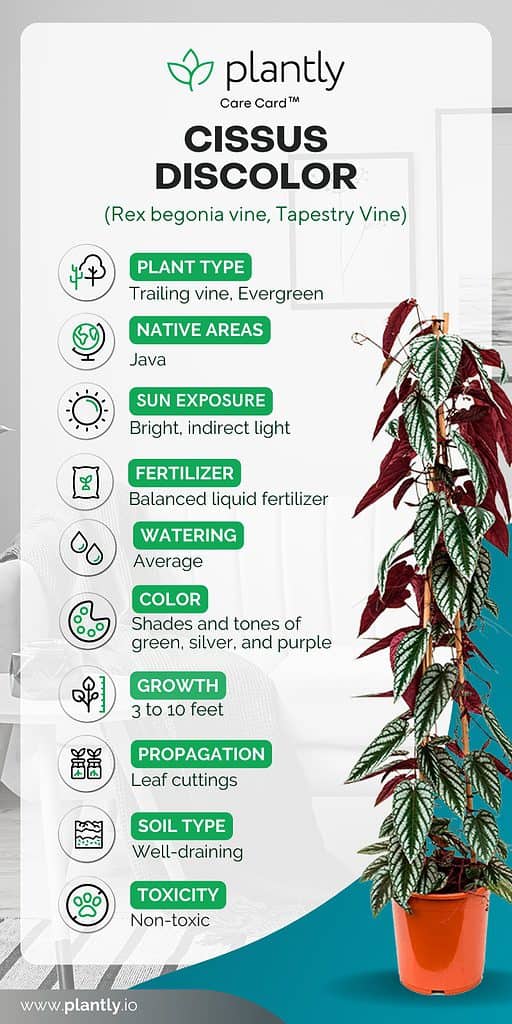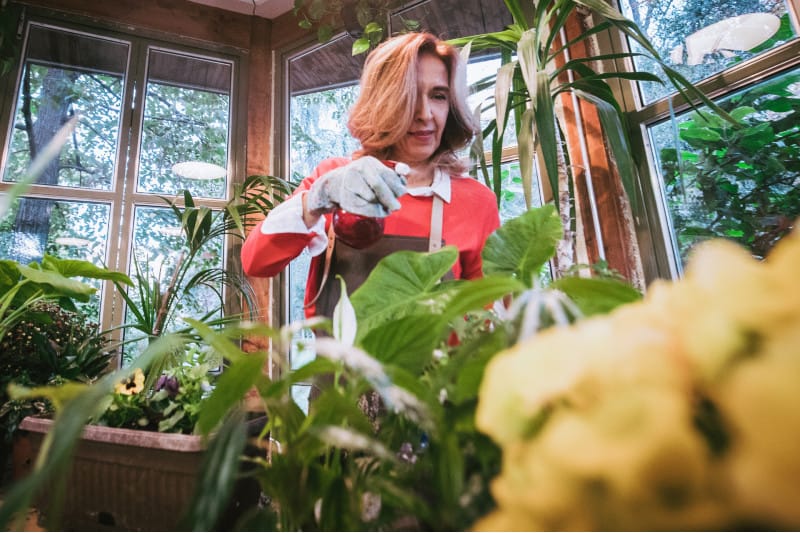No products in the cart.
Table of Contents
Cissus discolor has become a popular houseplant due to its huge, stunning leaves and climbing growth. People even name the plant the Cissus discolor Rex begonia vine because of the fascinating design of the broad, long leaves.
However, this famous outdoor plant is not a member of the Begonia family but is closely linked to the Vitaceae family (Grape Vine).

It features enormous, attractive, and colorful heart-shaped leaves in various colors and tones of green, silver, and purple. This plant’s bottom and tendrils have a lovely burgundy to deep purple color, making it incredibly attractive. It’s rare for the Cissus discolor Rex begonia to flower in normal circumstances.
But it’s generally ideal for maintaining your plant outside in high humidity and bright light to give it a better chance of flowering. The blossoms of this vine are usually pale yellow to white in color and modest in size when it decides to bloom.
Want to add this to your hanging basket? That’s a perfect choice, I tell you! Keep reading because there’s more below!
Cissus Discolor Plant Care Basics
Firstly, have a quick glance at the plant’s overview. It will help you gain more knowledge to know more about this Rex begonia vine cissus.

Best Potting Mix
These plants need nutrient-rich and well-draining soil. You can make your own by combining 50% standard potting soil, 40% perlite for increased drainage, and 10% peat moss for added nutrients. While most potting mixes already contain peat moss or coconut coir, a little more won’t hurt.
Always pay attention to the label! Your Rex begonia vine cissus also prefers to keep its soil moist and a little acidic to neutralize (pH 6.0 to 7.0).
Pro tip: Avoid potting mixes that contain compost or bark, as these might lead to gnat infestations.
Watering Needs
When it comes to watering, remember that you must adjust the schedule according to the season’s temperature. The upper layer of the soil should have at least 30% moisture from spring through fall. As a result, keep the soil moist and water it before it dries out.
Also, soak the soil until extra water drains from the drainage holes after watering. Remember that this plant can die if it is overwatered. Your plant may develop root rot if you overwater it. So, keep an eye on it.
On the other hand, on cooler days, cut back on the watering. Water the plant only when the soil is parched in the winter.
Ideal Lighting

When grown in low-light situations, the beautiful colorations of these plants, especially the silvery ones, may be lost. Plus, they will also grow slowly. Contrastingly, direct sunlight will burn the Begonia vine Cissus discolor leaves, which are pretty sensitive.
Foliage discoloration can also be caused by too much direct light.
So, what’s the best light? Well, bright indirect or partial shade is needed for the Cissus Discolor. You can keep it near an east-facing window for the most delicate color. This will make the plant benefit from the soft morning sun while avoiding the harsh rays in the afternoon.
Temperature & Humidity
The ideal temperature for growing Cissus discolor is 65 to 80oFahrenheit (18 to 27oCelsius). Because the temperature inside a home does not vary greatly, you can cultivate this plant indoors without managing the temperature. These plants prefer to be kept warm and have a low frost tolerance.
It is critical to move plants to warm zones as soon as the fall arrives in zones with harsh winters and frosts.
For rich development of the dark green foliage, Cissus discolor requires high humidity. Its vast, beautiful leaves need a lot of water to keep fresh and lush. Ideally, the air should contain more than 60% moisture. So, consider using a humidifier, misting, or placing a pebble-water tray under the pot to add moisture on dry days.
Misting leaves regularly can help enhance humidity, but be careful because moist leaves can attract various pests and insects.

Note: Your Rex begonia vine may shrivel/wilt, or the leaves may become yellow, have brown edges, or be crispy and dry when planted in low humidity. Additionally, the leaves may fall from time to time.
Fertilizer Requirement
For healthy development and more flowers, this plant requires fertilization. Your plant will have limited growth and nearly no new leaves if you do not fertilize it even once. Feed it with a balanced liquid fertilizer once every 5-7 weeks during the summer and spring.
Dosage and directions should be found on the label. However, on colder days, these vines, like most plants, do not require any additional fertilizer.
Pro tip: Alternatively, this Rex Begonia Vine can be fertilized with a high potassium fertilizer. Potassium promotes development and increases drought tolerance. Before applying fertilizer, you should constantly hydrate the plant.
Propagation
If you know the basics, propagating this plant is simple! Cissus discolor leaf cuttings can be used to cultivate this vine. This is a simple method for propagating this plant from a leaf-tip cutting. Also, you should propagate them in their growing season to have more chances of surviving.
So, here’s how you will propagate your Discolor Rex begonia vine:
- Take a sharp knife and use ethanol to disinfect it.
- Cut 2-3 leaf cuttings with the knife. Cut below the terminal node if possible.
- Although this is optional, you can dip the leaf-cutting nodes in growth hormone.
- Sphagnum moss should be placed in a separate container. Then, lightly water the moss.
- Cover the cutting with sphagnum moss and plastic covering.
- Make holes in it so that air may circulate.
- Placing the container in direct sunlight is a good idea.
- In just a few weeks, new growth will emerge. And you will have your new Cissus discolor!
Growth Zone
Zones 9 and 10a of the USDA are excellent for these plants. In addition, if the plant is maintained warm during the winter, it can thrive in higher zones.
Potting
Hanging baskets are an excellent way to keep these vines looking their best. Many individuals, however, make an effort to teach these plants to climb up the supports in terrestrial pots with trellis.
Cissus javana must be repotted every two years. As soon as the plant outgrows its previous pot, this should be done. You should do this in their growing season. For each new pot, you should constantly use fresh potting soil. Also, use a pot that is one size larger than the one you used before.
Pruning
To grow larger, this evergreen vine does not require pruning or trimming. You can, however, trim or chop back its foliage to encourage additional branching and growth. If you want to keep your Cissus discolor in good health, trim it once a year at the start of the growing season.
Pro tip: Pruning shears or scissors that have been sterilized should be used. You don’t want to infect your plant with disease-carrying scissors.
Cissus discolor Plant Varieties and Similar Plants
There are also many beauties like this Begonia vine Cissus discolor. Each with its own unique appearance, and I know you will surely have them all!
Here are the different varieties of Cissus:
Amazon Jungle Vine

A beautiful vine from the Brazilian jungles with frosted green leaves in the shape of an arrow. The leaves are dual-toned, with green on top and burgundy, red, or pink underneath.
Kangaroo Vine

This climbing plant is an Australian native. It’s a fast-growing houseplant that thrives in a range of light situations from low to bright. The plant’s leaves are glossy and oval in shape, with serrated borders.
Princess Vine

With its glossy heart-shaped leaves and thin tendrils, the vine looks lovely. It thrives in bright, indirect light and looks stunning in compact pots.
Cissus Discolor Plant Diseases & Pests
One of the Cissus discolor care guides include watching out for pests and diseases that can harm your beauty. No worries, because we will tell you about them.
Pests
The common pests that can infect this plant are Whitefly, Mealybugs, and Red spider mites. Using a mix of dish soap and water, neem oil, and soapy water or rubbing alcohol, manually remove the eggs of the Whiteflies.
Use rubbing alcohol with a few drops of dishwashing soap, a hose to dislodge your plant, neem oil, and natural pyrethrum sprays are good remedies for mealybugs. And lastly, the use of pyrethroid-containing insecticidal soaps or diluted liquid dish soap.
Diseases
These attractive plants are not sensitive to many diseases when grown indoors. They may get leaf spots and powdery mildew if you use unsterilized pruning scissors or grow them outside.
Powdery mildew appears as whitish to gray patches or blotches with talcum-like development. Make use of a fungicide. On the other hand, Leaf spot appears as black or dark patches on the leaves that begin as water-soaked lesions and quickly turn black.
You can remove any leaves that are damaged and care for them again like a baby plant.
Frequently Asked Questions
Overwatering or underwatering is the most likely cause of your Cissus discolor dropping leaves. Low humidity might also create this issue or shock. So, have a checklist of the symptoms and point out the possible treatment.
In the winter, these vines go dormant. Don’t be alarmed if you detect browning or falling leaves. Continue to love and care for it. In the spring, it should reappear cheerfully!
Yes! This plant is a pretty rare iridescent plant.
You can now have this beauty here at Plantly! Yes! We offer faster transactions online, plus! We will deliver your plant in good condition. Don’t waste this opportunity and buy them while the stocks last. Message us now!
Whether you want to buy, sell or simply reach out to other plant enthusiasts, Plantly is the right place to be!


